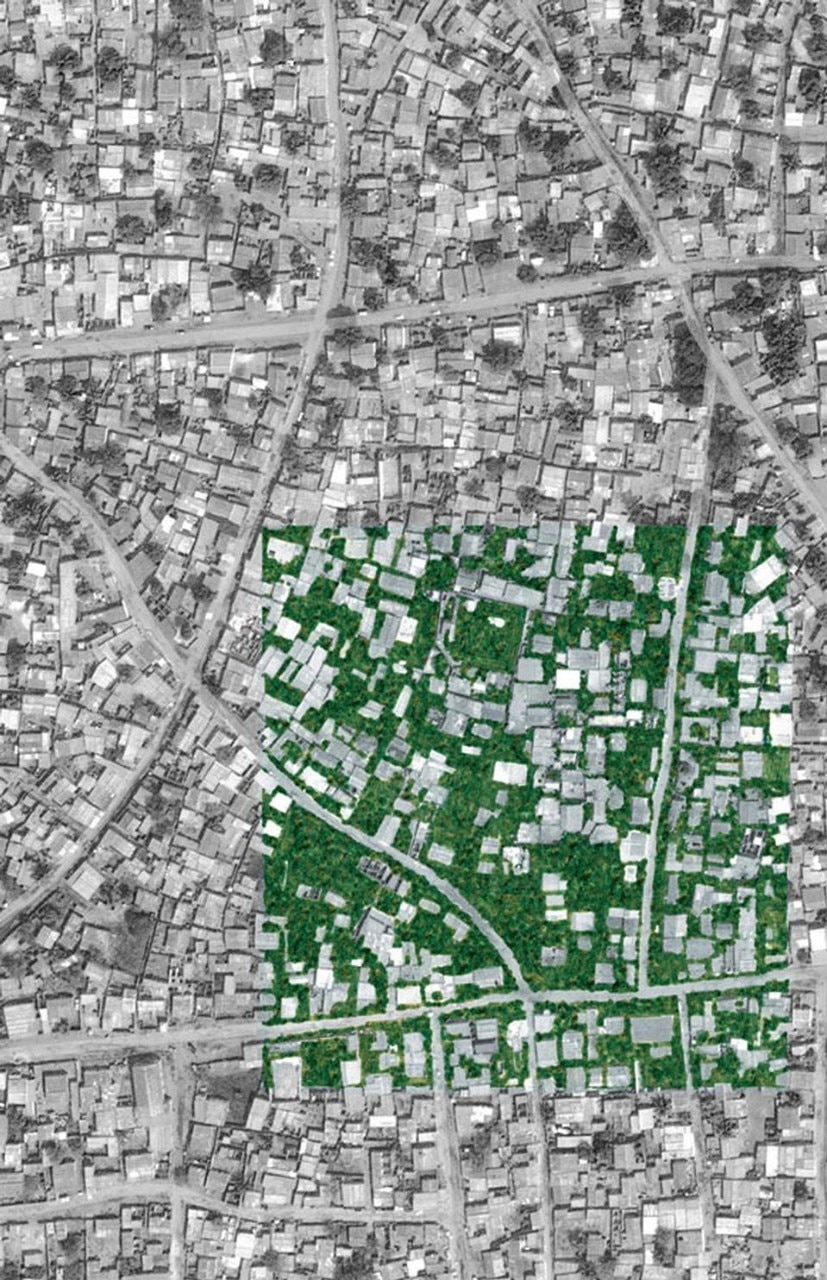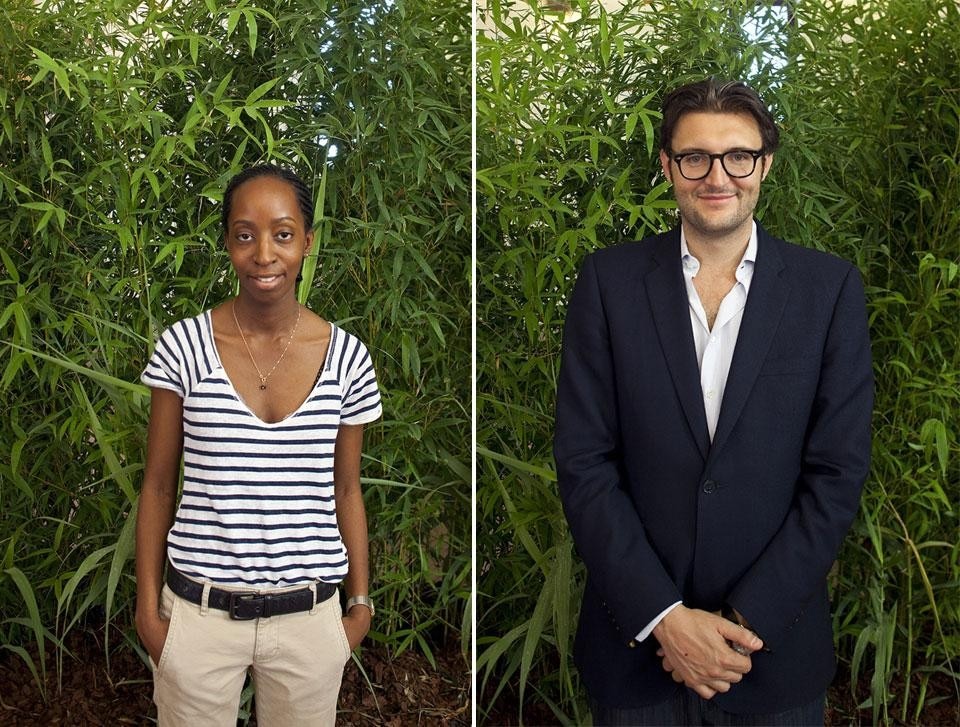Vera Sacchetti: My first impression when I got here was this wall of green. It speaks a lot about transformation of the landscape, and it also takes me back to land art. Could you explain me the concept behind this installation?
Paula Nascimento: The primordial ideal is that by changing nothing we change everything. And that then drives the rest of the project.
Stefano Rabolli Pansera: This is the essence: the green is everywhere, it's one of these words that architects use repeatedly nowadays. The proposal is ultimately a critique to the notion of green as a park or leisure or entertainment, which is now a mindset defined by the big dogmas of urban planning. In the past, it wasn't like this. During the middle ages, gardens were actually agricultural, domesticated spaces. In the 16th century, the baroque garden was a form of power, of organization of the territory. Then came the picturesque garden, and today we think about a green lung for the city. Our proposal is a critique to this notion. It uses the green as an undecided moment, neither just public space, nor just sewage, nor just infrastructure, but the three things simultaneously. This new possibility is very coherent with what we think is the inner nature of the African city, a morphing city, in constant becoming. Our proposal for a Common Ground is one that is morphing.
And these plants — bamboo and the Arundo Donax cane — indigenous to Angola?
PN: They grow everywhere where you have a temperate climate. For example, we never think of bamboo in Angola, but there is bamboo there, so Arundo Donax could also grow there.
So here we are sitting in a negative space. We are inside a house, actually. How was this design determined?
SRP: The space was mapped, in a workshop we did with Universidade Metodista de Angola.
PN: We took 15 students to the Casenga neighbourhood and we entered the neighbourhood, mapped living spaces, talked to people, took photographs: we did a whole cultural and architectural mapping of the space. And then we took a fragment of the neighbourhood where we were, and that basically is the space you see here. This is a 1:1 scale of a home that could house 10 to 12 people inside.
You transported this map here and filled the in-between spaces with green. What could these plants do?
PN: The roots of Arundo Donax are very thin, and they can purify the water. Obviously it isn't drinkable water, but it becomes reusable water. The plants grow one metre a month, and they are one of the biggest absorbents of CO2 that exist. When cropped, they can be burnt and transformed into biomass, or energy that could be used by the houses.
You are making a statement in favour of a new kind of urbanism for the African city. What are the differences between this "new" urbanism and the one currently underway in Africa?
SRP: It's a cultural issue, in the sense that not just in Africa, but in whole the world, often people, authorities, and cultural models are imposed as progress and as the future. In Africa, the American model of the gated community and the Chinese model of the high-rise are very often taken as the images of future, of progress. Our model is not opposed to this, but is instead an alternative, complementary to these models. These ideas are projected into the African city and we fail to understand the richness, the intensity of what is often defined as an informal city. Our proposal embraces the complexity of the informal city: we named it after our personal take on it — the "Morphing City". And I would like to highlight that this city, and this model, cannot be associated with mixed use — a set of defined, different programs under the same roof. The morphing city is one where the very space constantly "becomes other from itself." And this is something that is really ungraspable, if we use the usual categories of zoning. Even the Cartesian idea of space is something that is fixed, defined and measurable. In our take of the African city, space becomes a temporary moment of a continuous becoming, and this project engages with this idea of multiform, ever-changing, metamorphic reality.

PN: Yes, but it could be adaptable. The beauty of it is that it is so non-formal that it could be adaptable to many parts of the city, or even of the country. Ideally, we would like to install it in Luanda, and create a proper common ground there. But it could be installed not just between the buildings but in spaces where you have open-air sewage. And then what you create is that the sewage becomes a public space as well. At the moment, it is an accumulator of trash, disease. And people play around it. But imagine if you have plants filtering the water, you have educational programs telling people not to throw more trash in there, you can actually create these in-between parks, a public space in the city.
How has the state been involved in this proposal and what are your goals with it, can it be taken further?
PN: The ultimate goal of the project is to be implemented, either in a small village as a prototype, or within the city, or even as a complementary, as Stefano said, to any of the new urbanisation projects. The local authorities were quite keen on the project, but obviously there are a couple of issues that accompany the implementation of a project such as this one: legal, economical and other sorts of issues.
SRP: I think it is really, as Paula is highlighting, a cultural problem. Because the technology is already being used in other parts of Africa and it works. We are really proposing a cultural model, and this is why it was so important for us to present the work in the Biennale, such a prestigious platform, suggesting a new paradigm for thinking the city: a new mental model, a new horizon, where nature is not opposed to infrastructure, but morphing.

PN: It's probably radical in its intentions, and because people are not thinking in that way, but at the same time the effect onto spaces is very calm and relaxing. But I also think when working with natural elements there is always a level of expectation that goes beyond what you expect, because you can draw the proposal but you cannot, for example, plan that smell will be so intense here, that it would be such a cool atmosphere, that's an added item and it's fantastic I think.
SRP: Apparently, it's very quiet, and as always the most quiet things are generally the most revolutionary. But even the idea of using the common ground as a shared resource can be very controversial. Because the idea is that every plant can create a new economy because each family produces its own electricity and can potentially sell the electricity to the neighbours. Who is the owner of this electricity? Who manages the common ground? Which are the forms through which this energy is organised and managed? In all its complexity, the project maintains a level of ambiguity, which is the richness of the African city and Luanda especially.
Even though we really can identify certain paradoxes within the African city, we cannot say there is "one" African city. Luanda is a paradigm; I can find similarities between Luanda and Lagos, for example, but there are also very big differences

SRP: I think this is one way to engage this idea of morphing, which in our opinion gives a good passe-partout, a good key to understand everything, but it isn't obviously the only one. And there may be other readings. The works that have recently been done in other contexts and informal cities, for example Rio de Janeiro's favelas are very interesting. They are very different from the African city's musseque, totally different situations, but they share with us a sensibility that starts from the analysis of the "special intelligence" of these kinds of cities and then moves on. I think this is one of the proposals that moving in a specific direction, that rejects the imposition of a foreign model, but it is not the only one, and not unique, but it could work very well.
PN: Especially because even though we really can identify certain paradoxes within the African city, we cannot say there is "one" African city. Luanda is a paradigm; I can find similarities between Luanda and Lagos, for example, but there are also very big differences. So in that way, there are other ways and other models that could address these issues within the city.


